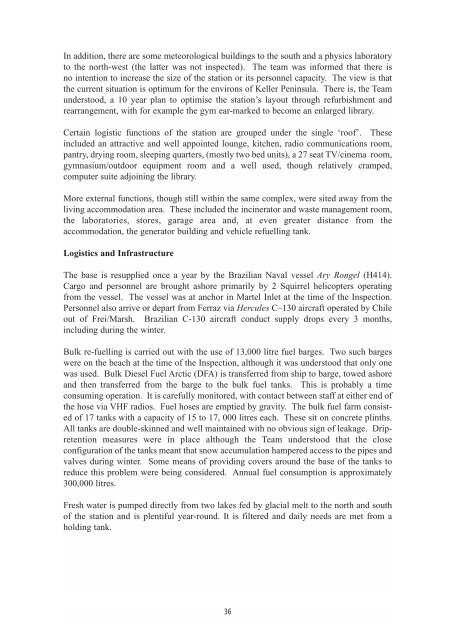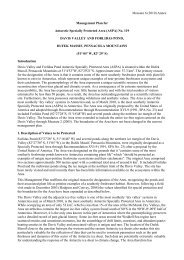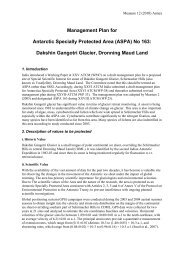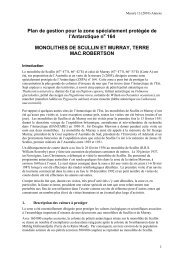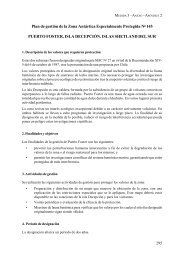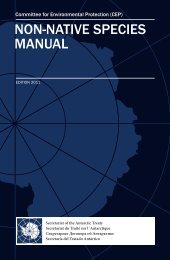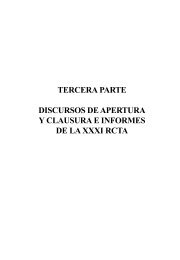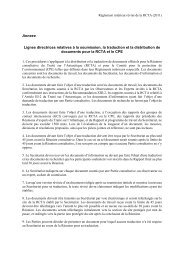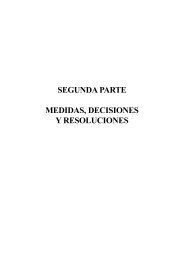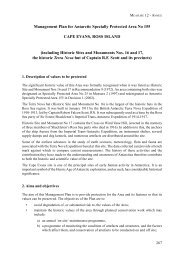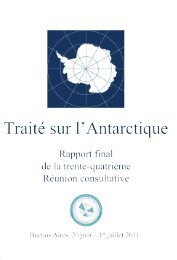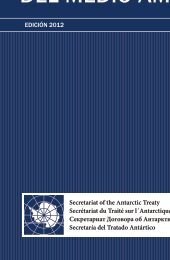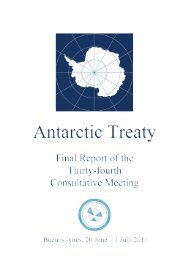Antarctic Treaty Inspections 2005 - Antarctic Treaty Secretariat
Antarctic Treaty Inspections 2005 - Antarctic Treaty Secretariat
Antarctic Treaty Inspections 2005 - Antarctic Treaty Secretariat
You also want an ePaper? Increase the reach of your titles
YUMPU automatically turns print PDFs into web optimized ePapers that Google loves.
In addition, there are some meteorological buildings to the south and a physics laboratory<br />
to the north-west (the latter was not inspected). The team was informed that there is<br />
no intention to increase the size of the station or its personnel capacity. The view is that<br />
the current situation is optimum for the environs of Keller Peninsula. There is, the Team<br />
understood, a 10 year plan to optimise the station’s layout through refurbishment and<br />
rearrangement, with for example the gym ear-marked to become an enlarged library.<br />
Certain logistic functions of the station are grouped under the single ‘roof’. These<br />
included an attractive and well appointed lounge, kitchen, radio communications room,<br />
pantry, drying room, sleeping quarters, (mostly two bed units), a 27 seat TV/cinema room,<br />
gymnasium/outdoor equipment room and a well used, though relatively cramped,<br />
computer suite adjoining the library.<br />
More external functions, though still within the same complex, were sited away from the<br />
living accommodation area. These included the incinerator and waste management room,<br />
the laboratories, stores, garage area and, at even greater distance from the<br />
accommodation, the generator building and vehicle refuelling tank.<br />
Logistics and Infrastructure<br />
The base is resupplied once a year by the Brazilian Naval vessel Ary Rongel (H414).<br />
Cargo and personnel are brought ashore primarily by 2 Squirrel helicopters operating<br />
from the vessel. The vessel was at anchor in Martel Inlet at the time of the Inspection.<br />
Personnel also arrive or depart from Ferraz via Hercules C–130 aircraft operated by Chile<br />
out of Frei/Marsh. Brazilian C-130 aircraft conduct supply drops every 3 months,<br />
including during the winter.<br />
Bulk re-fuelling is carried out with the use of 13,000 litre fuel barges. Two such barges<br />
were on the beach at the time of the Inspection, although it was understood that only one<br />
was used. Bulk Diesel Fuel Arctic (DFA) is transferred from ship to barge, towed ashore<br />
and then transferred from the barge to the bulk fuel tanks. This is probably a time<br />
consuming operation. It is carefully monitored, with contact between staff at either end of<br />
the hose via VHF radios. Fuel hoses are emptied by gravity. The bulk fuel farm consisted<br />
of 17 tanks with a capacity of 15 to 17, 000 litres each. These sit on concrete plinths.<br />
All tanks are double-skinned and well maintained with no obvious sign of leakage. Dripretention<br />
measures were in place although the Team understood that the close<br />
configuration of the tanks meant that snow accumulation hampered access to the pipes and<br />
valves during winter. Some means of providing covers around the base of the tanks to<br />
reduce this problem were being considered. Annual fuel consumption is approximately<br />
300,000 litres.<br />
Fresh water is pumped directly from two lakes fed by glacial melt to the north and south<br />
of the station and is plentiful year-round. It is filtered and daily needs are met from a<br />
holding tank.<br />
36


